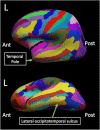Cortical and subcortical changes following sphenopalatine ganglion blocks in chronic migraine with medication overuse headache: a preliminary longitudinal study
- PMID: 32774872
- PMCID: PMC7409446
- DOI: 10.1186/s40695-020-00055-y
Cortical and subcortical changes following sphenopalatine ganglion blocks in chronic migraine with medication overuse headache: a preliminary longitudinal study
Abstract
Objective: The purpose of this pilot study was to investigate potential changes in brain morphology (cortical thickness and cortical/subcortical volume) accompanying a series of sphenopalatine ganglion (SPG) blockade treatments in chronic migraine with medication overuse headaches (CMw/MOH).
Background: Local anesthetization of the SPG via intranasal application is used for the treatment for multiple types of headache disorders, including CM. Our previous longitudinal fMRI study revealed improved network connectivity after such treatment. However, the impact of SPG blocks on cortical, subcortical gray matter volume and cortical thickness has yet to be assessed.
Methods: Using magnetic resonance imaging (MRI), cortical/subcortical volume were measured in 12 chronic migraine patients before and after a series of 12 SPG blocks administered over a 6-week period (2 per week). The average time between MRI assessments was 6 weeks. Targeted, within-subjects t-tests comparing pre-treatment and post-treatment values in specific apriori brain regions of interest, including the hippocampus, amygdala, basal ganglia, somatosensory cortex, temporal cortex and occipital cortex, were used to estimate the impact of repetitive SPG blocks treatment on brain morphology in CMw/MOH.
Results: Compared to baseline values, the number of moderate/severe headache days per month, HIT-6, PHQ-9 scores and allodynia scores were all significantly improved at the end of treatment. Analysis of MRI data revealed that the volume of the right hippocampus and the right palladium significantly decreased following SPG block treatment, while the volume of the left nucleus accumbens significantly increased following treatment. Cortical thickness in the left temporal pole and left lateral occipito-temporal gyrus significantly decreased following SPG block treatment.
Conclusion: Our results suggest SPG block treatment is associated with significant symptom improvement as well as significant structural brain changes in regions known to be associated with migraine and chronic pain processing in CMw/MOH.
Keywords: Chronic migraine; Cortical thickness; Medication overuse headache; Sphenopalatine ganglion; Voxel-based morphometry.
© The Author(s) 2020.
Conflict of interest statement
Competing interestsThe authors declare no competing interests.
Figures


Similar articles
-
Resting State Functional Connectivity After Sphenopalatine Ganglion Blocks in Chronic Migraine With Medication Overuse Headache: A Pilot Longitudinal fMRI Study.Headache. 2018 May;58(5):732-743. doi: 10.1111/head.13318. Headache. 2018. PMID: 29878344
-
A double-blind, placebo-controlled study of repetitive transnasal sphenopalatine ganglion blockade with tx360(®) as acute treatment for chronic migraine.Headache. 2015 Jan;55(1):101-16. doi: 10.1111/head.12458. Epub 2014 Oct 23. Headache. 2015. PMID: 25338927 Free PMC article. Clinical Trial.
-
Long-term efficacy of a double-blind, placebo-controlled, randomized study for repetitive sphenopalatine blockade with bupivacaine vs. saline with the Tx360 device for treatment of chronic migraine.Headache. 2015 Apr;55(4):529-42. doi: 10.1111/head.12546. Epub 2015 Mar 31. Headache. 2015. PMID: 25828648 Free PMC article. Clinical Trial.
-
Sphenopalatine Ganglion Block in the Management of Chronic Headaches.Curr Pain Headache Rep. 2017 Jun;21(6):27. doi: 10.1007/s11916-017-0626-8. Curr Pain Headache Rep. 2017. PMID: 28432602 Review.
-
Trans-nasal sphenopalatine ganglion block for post-dural puncture headache management: a meta-analysis of randomized trials.Braz J Anesthesiol. 2023 Nov-Dec;73(6):782-793. doi: 10.1016/j.bjane.2023.06.002. Epub 2023 Jul 6. Braz J Anesthesiol. 2023. PMID: 37422191 Free PMC article. Review.
Cited by
-
Imaging the brain and vascular reactions to headache treatments: a systematic review.J Headache Pain. 2023 May 24;24(1):58. doi: 10.1186/s10194-023-01590-5. J Headache Pain. 2023. PMID: 37221469 Free PMC article.
-
Longitudinal differences in iron deposition in periaqueductal gray matter and anterior cingulate cortex are associated with response to erenumab in migraine.Cephalalgia. 2023 Feb;43(2):3331024221144783. doi: 10.1177/03331024221144783. Cephalalgia. 2023. PMID: 36756979 Free PMC article.
-
Tracking tDCS induced grey matter changes in episodic migraine: a randomized controlled trial.J Headache Pain. 2021 Nov 20;22(1):139. doi: 10.1186/s10194-021-01347-y. J Headache Pain. 2021. PMID: 34800989 Free PMC article. Clinical Trial.
-
Pain in midlife women: a growing problem in need of further research.Womens Midlife Health. 2022 May 5;8(1):4. doi: 10.1186/s40695-022-00074-x. Womens Midlife Health. 2022. PMID: 35509086 Free PMC article.
-
Supplementing transcranial direct current stimulation to local infiltration series for refractory neuropathic craniocephalic pain: A randomized controlled pilot trial.Front Neurol. 2023 Mar 1;14:1069434. doi: 10.3389/fneur.2023.1069434. eCollection 2023. Front Neurol. 2023. PMID: 36937523 Free PMC article.
References
-
- Lebovits AH, Alfred H, Lefkowitz M. Sphenopalatine ganglion block: clinical use in the pain management clinic. Clin J Pain. 1990;6:131–136. - PubMed
-
- Khan S, Schoenen J, Ashina M. Sphenopalatine ganglion neuromodulation in migraine: what is the rationale? Cephalalgia. 2014;34:382–391. - PubMed
-
- Schoenen J. Sphenopalatine Ganglion Stimulation in Neurovascular Headaches. Prog Neurol Surg. 2015;29:106–116. - PubMed
-
- Tepper SJ, Rezai A, Narouze S, et al. Acute treatment of intractable migraine with sphenopalatine ganglion electrical stimulation. Headache. 2009;49:983–989. - PubMed
LinkOut - more resources
Full Text Sources
Other Literature Sources

